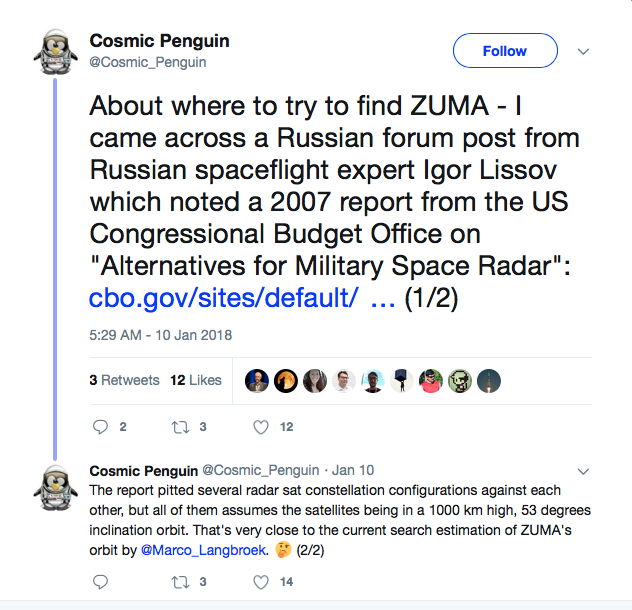Zuma: A New Twist On Space Radar?
Posted on

Falcon 9 carrying Zuma satellite at launch
WASHINGTON: Before we go any further, this story is based on direct observations of what was believed to be the so-called Zuma satellite, as well as a lot of spookily sourced information, most of it from a single source who shall not be identified.
First, nobody who doesn’t have extremely high clearance really knows if Zuma is in orbit or has been lost. Several sources I spoke with noted that remaining silent about the satellite would be excellent cover for the program, though that sounds more cunning than I’d expect. Second, the Northrop Grumman satellite may be a follow-on to another failed satellite US 193. When I was at Space News when US 193 went rogue, a source with direct knowledge of the program told me it was a blend of radar and electro-optical and would not provide any more detail than that. A source with wide knowledge of classified space programs has told me that the Northrop Grumman-built Zuma may be the next iteration of this. Both were apparently experimental satellites, in that they were not part of a large constellation of similar satellites.
Some very interesting informed speculation about Zuma’s apparent mission, based largely on its predicted orbit, its launch and several early sightings, points to it being a space radar satellite of some sort. Assuming it is a radar satellite, it should belong to everyone’s favorite space spooks, the NRO.
One of the world’s tiny group of eerily well-informed satellite watchers, Marco Langbroek, penned estimates about the satellite’s position from its launch and some early sightings that prompted this speculation by a colleague of his, known as Cosmic Penguin (a Hong Kong-based satellite tracker whose identity is not easily ascertained online).

Langbroek took that information and speculated about just what that arc of positions would allow the satellite to do: “Indeed, a satellite in a Zuma-like orbit would basically cover all Ocean surfaces, except for the high Arctic and Antarctic, which are not that interesting for the purpose discussed below (moreover, the Arctic is extensively covered by groundbased and airborne radar).”
But let’s be honest. None of us really knows at this stage, though past experience with the satellite tracker community gives me pretty high confidence they are on the right track when combined with the information from my single source.
Now the other issues: Did the satellite fall to earth as several outlets have reported, and was SpaceX’s Falcon 9 to blame for that failure, if it occurred? On the first issue, we really don’t know if the satellite is in orbit or not, yet. Satellite trackers may well locate it in 10 days or so, unless, of course, it has fallen to earth. We know it made it to orbit, but, the Northrop Grumman-built payload adapter may have malfunctioned, dragging the satellite back down with it.
SpaceX President Gwynne Shotwell issued an aggressively worded defense of their launch system on Tuesday, which, on its face, appears to rule out problems with Falcon 9: “For clarity: after review of all data to date, Falcon 9 did everything correctly on Sunday night. If we or others find otherwise based on further review, we will report it immediately. Information published that is contrary to this statement is categorically false. Due to the classified nature of the payload, no further comment is possible.”
My old boss Lon Rains, now the top space spokesman at Northrop, has only said the company won’t comment on the classified mission. That may change, depending on what we learn and what they’re allowed to tell the public.
Subscribe to our newsletter
Promotions, new products and sales. Directly to your inbox.
